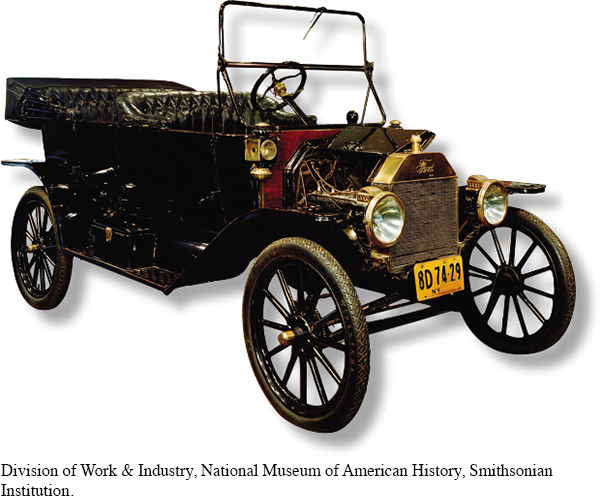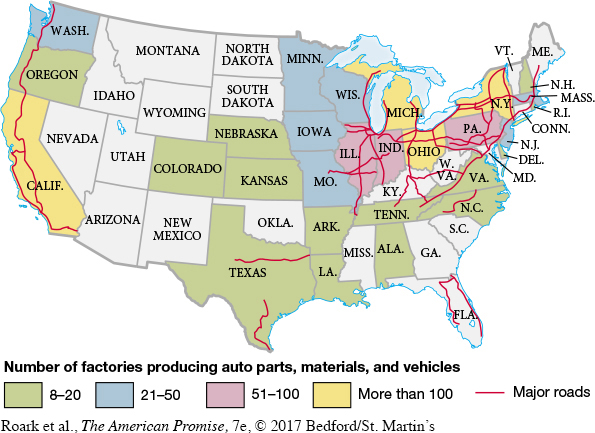The American Promise: Printed Page 649
The American Promise, Value Edition: Printed Page 592
The American Promise: A Concise History: Printed Page 674
Introduction to Chapter 23
The American Promise: Printed Page 649
The American Promise, Value Edition: Printed Page 592
The American Promise: A Concise History: Printed Page 674
Page 64923
From New Era to Great Depression
1920–

CONTENT LEARNING OBJECTIVES
After reading and studying this chapter, you should be able to:
Determine how business and industry contributed to a “New Era” and the growth of mass consumer and popular culture in the 1920s.
Describe the effectiveness of prohibition in the 1920s.
Explain how the “new woman” and the “New Negro” challenged social norms. Explain how some artists and intellectuals rejected America’s mass culture.
Evaluate ways in which social changes met with resistance, particularly in rural areas, and how this affected the presidential election of 1928.
Describe the various factors that contributed to the Great Crash of 1929. Explain President Hoover’s response and why it proved to be inadequate.
Describe how the Great Depression affected the lives of ordinary Americans.
AMERICANS IN THE 1920S CHEERED HENRY FORD AS AN AUTHENTIC American hero. When the decade began, he had already produced six million automobiles; by 1927, the figure reached fifteen million. In 1920, a Ford car cost $845; in 1928, the price was less than $300, within range of most of the country’s skilled workingmen. Henry Ford put America on wheels, and in the eyes of most Americans he was an honest man who made an honest car: basic, inexpensive, and reliable.
Born in 1863 on a farm in Dearborn, Michigan, Ford at sixteen fled rural life for Detroit, where he became a journeyman machinist. In 1893, he put together one of the first successful gasoline-

Ford’s early cars were custom-
The American Promise: Printed Page 649
The American Promise, Value Edition: Printed Page 592
The American Promise: A Concise History: Printed Page 674
Page 650When Ford began his rise, progressive critics condemned the industrial giants of the nineteenth century as “robber barons” who lived in luxury while reducing their workers to wage slaves. Ford, however, identified with the common folk and saw himself as the benefactor of average Americans. But like the age in which he lived, Ford was more complex and more contradictory than this simple image suggests.
A man of genius whose compelling vision of modern mass production led the way in the 1920s, Ford was also cranky, tightfisted, and mean-
Tension between traditional values and modern conditions lay at the heart of the conflicted 1920s. For the first time, more Americans lived in urban than in rural areas, and cities seemed to harbor everything rural people opposed. While millions admired urban America’s sophisticated new style and consumer products, others condemned postwar society for its loose morals and vulgar materialism. The Ku Klux Klan and other champions of an older America resorted to violence as well as words when they chastised the era’s “new woman,” “New Negro,” and surging immigrant populations. Those who sought to dam the tide of change proposed prohibition, Protestantism, and patriotism.
The public, disillusioned with the outcome of World War I, turned away from the Christian moralism and idealism of the Progressive Era. In the 1920s, Ford and businessmen like him replaced political reformers such as Theodore Roosevelt and Woodrow Wilson as the models of progress. The U.S. Chamber of Commerce crowed, “The American businessman is the most influential person in the nation.” The fortunes of the era rose, then in 1929 crashed, according to the values and practices of the business community. When prosperity collapsed, the nation entered the most serious economic depression of all time.
CHRONOLOGY
| 1920 |
|
| 1921 |
|
| 1922 |
|
| 1923 |
|
| 1924 |
|
| 1925 |
|
| 1927 |
|
| 1928 |
|
| 1929 |
|
| 1930 |
|
| 1931 |
|
| 1932 |
|